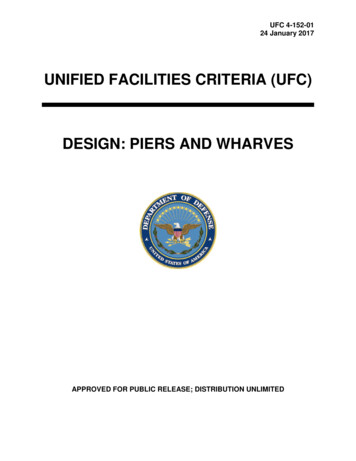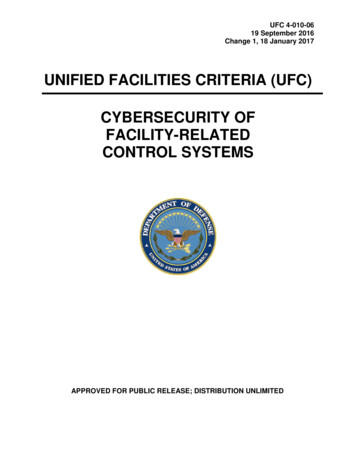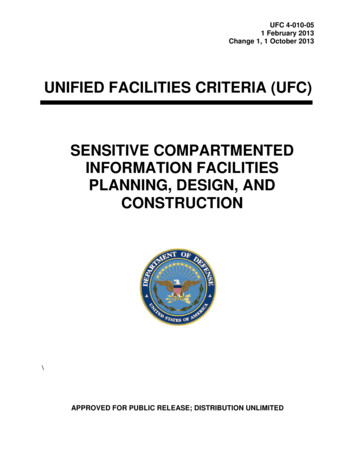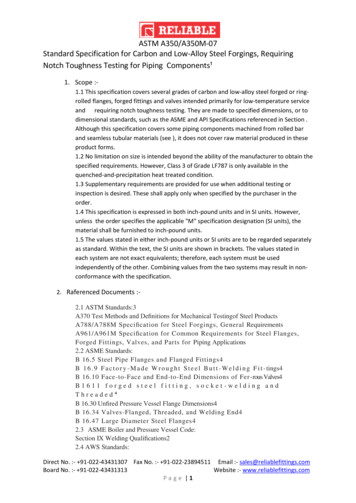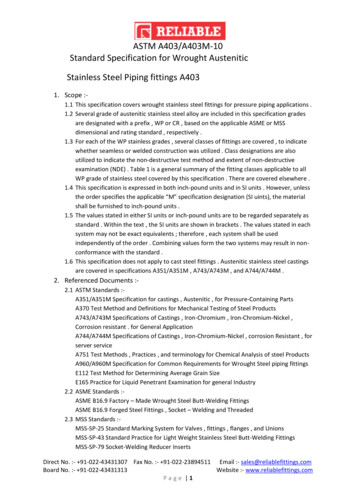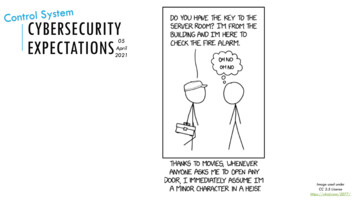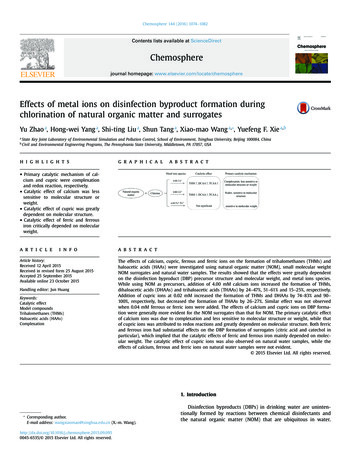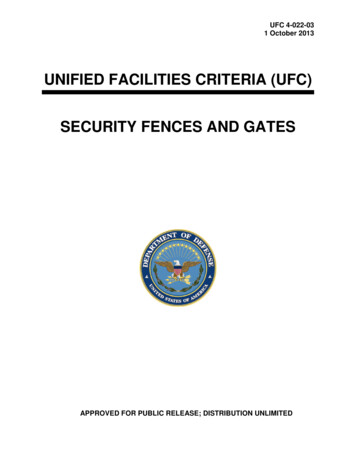
Transcription
UFC 4-022-031 October 2013UNIFIED FACILITIES CRITERIA (UFC)SECURITY FENCES AND GATESAPPROVED FOR PUBLIC RELEASE; DISTRIBUTION UNLIMITED
UFC 4-022-031 October 2013UNIFIED FACILITIES CRITERIA (UFC)SECURITY FENCES AND GATESAny copyrighted material included in this UFC is identified at its point of use.Use of the copyrighted material apart from this UFC must have the permission of thecopyright holder.U.S. ARMY CORPS OF ENGINEERSNAVAL FACILITIES ENGINEERING COMMAND (Preparing Activity)AIR FORCE CIVIL ENGINEER CENTERRecord of Changes (changes are indicated by \1\ . /1/)Change No.DateLocationThis UFC supersedes NAVFAC Military Handbook 1013/10, Design Guidelines forSecurity Fencing, Gates, Barriers, and Guard Facilities.
UFC 4-022-031 October 2013FOREWORDThe Unified Facilities Criteria (UFC) system is prescribed by MIL-STD 3007 and providesplanning, design, construction, sustainment, restoration, and modernization criteria, and appliesto the Military Departments, the Defense Agencies, and the DoD Field Activities in accordancewith USD (AT&L) Memorandum dated 29 May 2002. UFC will be used for all DoD projects andwork for other customers where appropriate. All construction outside of the United States isalso governed by Status of Forces Agreements (SOFA), Host Nation Funded ConstructionAgreements (HNFA), and in some instances, Bilateral Infrastructure Agreements (BIA.)Therefore, the acquisition team must ensure compliance with the most stringent of the UFC, theSOFA, the HNFA, and the BIA, as applicable.UFC are living documents and will be periodically reviewed, updated, and made available tousers as part of the Services’ responsibility for providing technical criteria for militaryconstruction. Headquarters, U.S. Army Corps of Engineers (HQUSACE), Naval FacilitiesEngineering Command (NAVFAC), and Air Force Civil Engineer Center (AFCEC) areresponsible for administration of the UFC system. Defense agencies should contact thepreparing service for document interpretation and improvements. Technical content of UFC isthe responsibility of the cognizant DoD working group. Recommended changes with supportingrationale should be sent to the respective service proponent office by the following electronicform: Criteria Change Request. The form is also accessible from the Internet sites listed below.UFC are effective upon issuance and are distributed only in electronic media from the followingsource: Whole Building Design Guide web site http://dod.wbdg.org/.Refer to UFC 1-200-01, General Building Requirements, for implementation of new issuanceson projects.AUTHORIZED BY:JAMES C. DALTON, P.E.JOSEPH E. GOTT, P.E.Chief, Engineering and ConstructionU.S. Army Corps of EngineersChief EngineerNaval Facilities Engineering CommandJOE SCIABICA, SESMICHAEL McANDREWDirectorDirector, Facilities Investment and ManagementAir Force Civil Engineer CenterOffice of the Deputy Under Secretary of Defense(Installations and Environment)
UFC 4-022-031 October 2013Unified Facilities Criteria (UFC)New Document Summary SheetDocument: UFC 4-022-03, Security Fences and Gates.Superseding: NAVFAC Military Handbook 1013/10, Design Guidelines for SecurityFencing, Gates, Barriers, and Guard Facilities.Document Description and Need:Purpose: This document is to provide a unified approach for the design, selection, andinstallation of security fences and gates. The examples provided in the UFC are forillustration only and must be modified and adapted to satisfy service and installationspecific constraints. This document is not intended to address procedural issues suchas threat level determination and security operations or to provide specific designcriteria such as impact forces.This UFC was developed by consolidating and refining criteria from USACE ProtectiveDesign Center, Naval Facilities Engineering Command (NAVFACENGCOM), andavailable military, government, and commercial sources that are listed in Appendix A ofthis document.Application and Use: Commanders, security personnel, planners, designers,architects, and engineers must use this UFC when evaluating existing and providingnew security fences and gates.Need: Fences and gates are primarily used to define perimeters; however, Departmentof Defense (DoD) and Service regulations require fencing to be provided for certainprotected/restricted areas. DoD and Service policies address certain fencingrequirements. This UFC focuses on the requirements for security fences, however, theinformation and design details presented within may also be used for general orperimeter fencing. Modifications to existing fencing are not required to meet this newUFC.Impact: The following direct benefits will result: This document does not set the requirement for security operations at theinstallation perimeter.No additional cost impacts are anticipated by the publication of this document.This document does not have any adverse impacts on environmental,sustainability, or constructability policies or practices.Unification IssuesThere are no unification issues.
UFC 4-022-031 October 2013TABLE OF CONTENTSCHAPTER 1 INTRODUCTION . 51-1PURPOSE . 51-2APPLICABILITY. 51-3SECURITY FENCES AND GATES . 51-4SCOPE AND GUIDANCE . 51-4.11-5Drawings . 5GENERAL BUILDING REQUIREMENTS . 51-5.1UFC Application . 61-5.2Requirements Determination . 61-5.3Integration With Other Requirements . 61-6VULNERABILITY AND RISK ASSESSMENT . 71-7POLICY REQUIREMENTS. 81-7.1Department of Defense (DoD) . 81-7.2Geographic Combatant Commander (GCC) Requirements . 91-7.3Service Requirements . 91-7.4Installation Specific Requirements . 111-7.5Airfield Requirements . 111-81-8.1PHYSICAL SECURITY . 11Physical Security System . 111-9EMERGENCY ACCESS . 121-10CORROSION PREVENTION CONTROL . 121-10.1Material Selection and Coatings . 121-11REFERENCES . 131-12GLOSSARY. 13CHAPTER 2 FENCING . 152-1FUNCTION . 152-2CHAIN LINK FENCING . 152-2.1Chain Link Fencing Fabric . 152-3ORNAMENTAL FENCES . 192-4WELDED WIRE MESH FABRIC FENCING . 192-4.12-5Fence Components, Fittings, and Accessories . 19EXPANDED METAL FENCING . 20i
UFC 4-022-031 October 20132-5.1Retrofit Existing Fence. 212-5.2Fence Components, Fittings, and Accessories . 212-6FARM STYLE FENCES . 212-7EXPEDITIONARY PERIMETER FENCING. 212-8FENCE FABRIC HEIGHT. 222-9TOP GUARDS . 222-9.1Outrigger/Barbed Wire Arm Material Specifications. 222-9.2Barbed Wire and Barbed Tape Concertina . 222-10GROUNDING . 242-11REINFORCEMENT FOR FENCING . 242-11.12-12Deadman Anchor . 25SPECIAL SECURITY FEATURES . 262-12.1Clear Zones . 262-12.2Double Fence Lines . 262-12.3Fence Line Electronic Security Systems. 292-12.4Security Lighting . 292-12.5Patrol Roads . 292-12.6Drainage Culverts and Utility Openings . 302-12.7Drainage Crossing . 332-12.8Tunneling Prevention . 34CHAPTER 3 GATES . 393-13-1.13-2GATES OVERVIEW . 39Access Control. 39PERSONNEL GATES . 393-2.1Single Swing Gates . 393-2.2Turnstile (Rotational) Gates . 403-3VEHICULAR GATES . 413-3.1Sliding Gates . 413-3.2Cantilevered Gates . 423-3.3Double Swing Gates . 423-3.4Vertical Pivot Gate . 443-3.5Overhead (Sliding) Gates . 443-3.6Vertical Lift Gate . 45ii
UFC 4-022-031 October 20133-4GATE REINFORCEMENT. 453-5LATCHES AND HINGES . 473-6LOCKING SYSTEM . 473-7GATE POWER OPERATORS. 483-7.1Sliding Gate Power Operators . 483-7.2Swing Gate Power Operators . 483-7.3Linear Induction Gate Operators. 48APPENDIX A REFERENCES . 49APPENDIX B GLOSSARY . 57B-1DEFINITION OF TERMS . 57APPENDIX C FENCE AND GATE DESIGN DETAILS . 61TABLESTable 2-1 Fence Type Components . 28Table 3-1: Gate Post Foundations . 43FIGURESFigure 1-1 Security and Antiterrorism UFC Application . 7Figure 1-2 Diagram of Physical Security System Functions . 12Figure 2-1: General Chain-Link Fence Components . 17Figure 2-2 Selvage . 18Figure 2-3: Welded Wire Mesh Fence . 20Figure 2-4: Expanded Metal Fence . 21Figure 2-5 Steel Cable-Reinforced Chain Link Fence . 25Figure 2-6: Deadman Anchor Detail . 26Figure 2-7a: Double Fence Line . 28Figure 2-7b: Double Fence Line . 29Figure 2-8: Large Culvert with Short Pipes. 30Figure 2-9: Steel Culvert Grill . 31Figure 2-10: Concrete Culvert Grill . 31Figure 2-11a: Utility Openings . 32Figure 2-11b: Utility Openings . 33Figure 2-12: Swale Crossing with Ground Stakes . 34Figure 2-13: Swale Crossing Embedded in Concrete . 35Figure 2-14a: Bar Grill Embedded in Concrete . 35Figure 2-14b: Bar Grill Embedded in Concrete . 36Figure 2-14c: Bar Grill Embedded in Concrete. 36Figure 2-15- Chain Link Fence over Ditch . 37Figure 3-1: Single Swing Gate . 40iii
UFC 4-022-031 October 2013Figure 3-2: Turnstile/Turnstile with Barbed Wire . 41Figure 3-3: Single Cantilevered Gate . 43Figure 3-4: Double Cantilevered Gate . 43Figure 3-5: Double Swing Gate . 44Figure 3-6: Locking Assembly for Reinforced Swing Gate . 46Figure 3-7: Locking Assembly for Reinforced Sliding Gate . 46Figure 3-8: Locking Assembly for Reinforced Vertical Lift Gate . 47iv
UFC 4-022-031 October 2013CHAPTER 1 INTRODUCTION1-1PURPOSEThis document provides a unified approach for the design, selection, and installation ofsecurity fences and gates for Department of Defense (DoD).1-2APPLICABILITYThis document applies to all construction, renovation, and repair projects includingexpeditionary or temporary construction that include security fencing and gates for DoD.Consult with current Service policies, location of facility, and threat level for specificrequirements.1-3SECURITY FENCES AND GATESSecurity fences and gates are installed and used primarily to define the perimeter ofprotected areas, such as restricted areas, controlled areas, entry control/access controlpoints, installation perimeters, and to provide a physical and psychological deterrent toentry and preventing unauthorized personnel from entering a protected area.1-4SCOPE AND GUIDANCECommanders, security personnel, planners, designers, architects, and engineers mustuse this UFC when evaluating existing and providing new security fences and gates.Technical information considered generally known to security professionals andengineers, or readily available in technical references (Unified Facility Criteria, MilitaryHandbooks, Technical Manuals, etc.) has not been included. This document is notintended to address procedural issues such as threat levels or to provide specific designcriteria such as vehicle impact forces.1-4.1DrawingsThe notional examples provided in the body of this UFC are for illustration and must bemodified for the specific application, environmental conditions, and local constraints.The details and drawings identified in Appendix C provide the minimum mandatoryrequirements and must be modified for the specific application, environmentalconditions, and local/project constraints. See paragraph titled ‘Integration With OtherRequirements’ for additional direction.1-5GENERAL BUILDING REQUIREMENTSComply with UFC 1-200-01, General Building Requirements. UFC 1-200-01 providesapplicability of model building codes and government unique criteria for typical designdisciplines and building systems, as well as for accessibility, antiterrorism, security, highperformance and sustainability requirements, and safety. Use this UFC in addition toUFC 1-200-01 and the UFCs and government criteria referenced therein.5
UFC 4-022-031 October 2013This UFC is one of a series of unified facilities criteria documents that cover minimumstandards, planning, preliminary design, and detailed design for security andantiterrorism. The manuals in this series are designed to be used by a diverseaudience to facilitate development of projects throughout the design cycle.1-5.1UFC ApplicationThe application of the security and antiterrorism UFCs is illustrated in Figure 1-1. UFC4-020-01 is intended to be the starting point for any project that is likely to have securityor antiterrorism requirements. By beginning with UFC 4-020-01, DoD SecurityEngineering Facilities Planning Manual, the design criteria will be developed thatestablishes which of the other UFCs in the series will need to be applied. The designcriteria may indicate that only the minimum standards need to be incorporated, or it mayinclude additional requirements, resulting in the need for application of additional UFCs.Applying this series of UFCs in the manner illustrated in Figure 1-1 will result in the mostefficient use of resources for protecting assets against security and antiterrorism relatedthreats.1-5.2Requirements DeterminationUFC 4-020-01 includes a process for defining the design criteria for a protective systemthat protects important assets associated with a permanent facility or one in anexpeditionary environment. The design criteria will consist of the assets to beprotected, the threats to those assets, the degree to which those assets will beprotected against the threat, and any constraints that might be imposed on a design.The design criteria may be limited to that defined in minimum standards or it may gobeyond those requirements.Establishing the design criteria for security and antiterrorism is not something that canbe done effectively by any one person. It requires a team of people to ensure that thevaried interests relating to a project are considered appropriately. The specificmembership of a planning team will be based on local considerations, but in general,the following functions should be represented - Facility User, Antiterrorism, Intelligence,Operations, Security, Logistics, Engineering, and Resource Management. Based onlocal considerations, there may be others who should be consulted for input into thedesign criteria. They might include Fire Marshals, communications people,environmental people, and historic preservation officers.1-5.3Integration With Other RequirementsSecurity and antiterrorism requirements will never be the only requirements associatedwith a project. Even where a project is specifically for security and antiterrorismupgrades, there will still be other requirements that must be considered. There will betimes where one criterion is more stringent than another, in which case the morestringent one must be applied. In some cases, criteria may conflict. In those cases,those conflicts must be resolved, which may require compromise or adjustment to oneor the other criteria. Many security regulations specify protective measures, policies,and operations related to security. This UFC is intended to complement those existing6
UFC 4-022-031 October 2013regulations, not to contradict or supersede them. Regulatory requirements must beaccommodated and coordinated.Figure 1-1 Security and Antiterrorism UFC Application1-6VULNERABILITY AND RISK ASSESSMENTIn accordance with DoD O-2000.12H Antiterrorism Handbook, a vulnerability and riskassessment must be conducted prior to beginning any security project. Upon identifyingfacility or asset vulnerabilities to threats, physical security measures such as securityfences, gates, and Electronic Security Systems (ESS) may be deployed to reducevulnerabilities. In summary, this UFC assumes the pre-design phases, including therisk analysis, are complete prior to beginning design. For information on Security7
UFC 4-022-031 October 2013Engineering Planning and Design process, refer to UFC 4-020-01 and UFC 4-020-02.The engineering risk analysis conducted as part of UFC 4-020-01 must be consistentwith the terrorism risk analysis conducted by the installation security/AT staff.1-7POLICY REQUIREMENTSThe requirement to protect installation assets comes from DoD Instruction/Directives,Geographic Combatant Commander (GCC) Instructions, Service Instruction/Directives,and Regional or Installation requirements. Consult Headquarters, Major Command,Regional, and Installation personnel to established installation asset protectionrequirements.1-7.1Department of Defense (DoD)There are several instructions and publications within the Department of Defense thatestablish requirements for access control and physical security for installation perimeter,restricted access areas and other secure areas.1-7.1.1DoD Physical Security ProgramDoD 5200.8-R: Requires DOD Components to determine the necessary access controlbased on the requirements of a developed physical security program. Emergencyplanning is specified to include establishment of a system for positive identification ofpersonnel and equipment authorized to enter and exit the installation and maintenanceof adequate physical barriers (i.e. security fences and gates) that will be employed tocontrol access to the installation.1-7.1.2Physical Security of Sensitive Conventional Arms, Ammunition, andExplosives (AA&E)DoD 5100.76-M prescribes minimum standards and criteria for the physical security ofDoD sensitive conventional AA&E. This Manual establishes the requirements to protectsensitive AA&E including perimeters, openings, and security fences.1-7.1.3Nuclear FacilitiesDoD S-5210.41-M Vols. 1-3, AFMAN 31-108, OPNAVINST 5210.16, and AR 190-54prescribe policy, responsibilities, procedures, and minimum standards for the securityand safeguarding of DoD nuclear reactors, special nuclear materials and weaponsincluding perimeters, openings, and security fences.1-7.1.4DoD Antiterrorism ProgramDoDI 2000.12: Provides DoD policies for ATFP and assigns responsibilities forimplementing physical security systems as part of the DoD ATFP Program. Itauthorized the publication of DODI 2000.16 Antiterrorism Standards as the DoDstandards for ATFP and DoD O-2000.12-H DoD Antiterrorism Handbook as guidancefor the DoD standards.8
UFC 4-022-031 October 20131-7.1.5DoD Antiterrorism HandbookDoD O-2000.12H: Defines the DoD Force Protection Condition (FPCON) System,which describes the potential threat levels and the applicable FPCON measures to beenacted for each level. FPCON measures in the 12-H were modified in DoDI 2000.16,Change 2 of 08 Dec 2006. DoD O-2000.12H also requires Commanders to developand implement Random Antiterrorism Measures (RAM) as an integral part of their ATProgram. This handbook provides a detailed discussion on physical security functionalrequirements of which physical barriers (security fences and gates) are integral.1-7.1.6DoD Antiterrorism StandardsDoD I 2000.16: This instruction requires the installation or activity Commanding Officerto define the access control measures at installations. Additionally, DoDI 2000.16requires Commanders at all levels to develop as part of the physical security programand implement a comprehensive Antiterrorism (AT) Program, which must define thenecessary action sets, including identification and inspection procedures, barrierrequirements at each of the potential Force Protection Condition (FPCON) levels andlists the most current approved FPCONS.1-7.2Geographic Combatant Commander (GCC) RequirementsGCC issue requirements for Antiterrorism and physical security for installations withintheir area of responsibility. Ensure any such requirements are incorporated in additionto the requirements found in DoD and Service Directives/Instructions. Resolve anydifferences in the requirements for the design of perimeter security by applying the moststringent requirement.1-7.3Service Requirements1-7.3.1Department of Air Force1-7.3.1.1AFI 31-101 – Integrated Defense (ID)(FOUO)This Instruction provides the tools to plan and execute ID. It guides personnel through afamiliar 7-step risk assessment process. Furthermore, working groups that are focusedon mutually-supporting components of ID, such as the antiterrorism (AT) program andresource protection program (RPP), may be combined and streamlined. ThisInstruction provides flexible planning and execution opportunities that allowowners/users of various Air Force assets to become actively involved in the defense oftheir areas; however, some assets must remain secured in accordance with higherheadquarters (HHQ) directives, such as nuclear weapons; arms, ammunition andexplosives (AA&E); classified information and Defense Critical Infrastructure Program(DCIP) assets.9
UFC 4-022-031 October 20131-7.3.1.2AFMAN 32-1084 Civil Engineering: Facility RequirementsThis Manual is a tool to assist commanders, their management, and technical staff inprogramming the acquisition of facilities and in managing the inventory of real propertyfacilities and provides additional guidance for fencing/barrier requirements.1-7.3.2Department of the Army1-7.3.2.1AR 190-13 The Army Physical Security ProgramImplements DOD 5200.08–R. It prescribes policies, procedures, and guidance to planand implement the Department of the Army Physical Security Program.1-7.3.2.2AR 190-16 Physical SecurityEstablishes standard policies on physical security systems planning, threat statements,control of access to installations, security of aircraft, bulk petroleum assets, and criticalcommunications facilities.1-7.3.2.3AR 190-11 Physical Security of Arms, Ammunition and ExplosivesRefer to AR 190-11 for physical security criteria for conventional arms, ammunition, andexplosives (AA&E) for additional guidance on fencing requirements.1-7.3.2.4ATTP 3-39.32 Physical Security: Army Tactics, Techniques, andProcedures (ATTP)Provides doctrinal guidance for personnel who are responsible for planning andexecuting physical security programs. It is the basic reference for training securitypersonnel and is intended to be used in conjunction with the Army Regulation (AR) 190series (Military Police), Security and Antiterrorism Unified Facilities Criteria (UFC)publications, Department of Defense (DOD) directives, and other Department of theArmy (DA) publications.1-7.3.3Department of the Navy including Marine Corps1-7.3.3.1OPNAVINST 5530.14 Navy Physical Security and Law EnforcementThe intent of this instruction is to identify responsibilities and provide guidance for theprotection of people and assets throughout the Navy.1-7.3.3.2Physical Security of Arms, Ammunition and ExplosivesRefer to OPNAVINST 5530.13 for physical security criteria for conventional arms,ammunition, and explosives (AA&E) and additional fencing requirements.1-7.3.3.3NTTP 3-07.2.3 Law Enforcement and Physical SecurityProvides guidance for the physical security for Naval Installations to include perimetersecurity and restricted areas.10
UFC 4-022-031 October 20131-7.3.3.4MCO 5530.14 Marine Corps Physical Security Program ManualProvides requirements for physical security for Marine Corps installations andorganizations including additional barrier/security fence requirements.1-7.4Installation Specific RequirementsAs required by DODI 2000.16 and service directives, each installation must have anAntiterrorism Plan. The plan provides procedures and recommen
applicability of model building codes and government unique criteria for typical design disciplines and building systems, as well as for accessibility, antiterrorism, security, high performance and sustainability requirements, and safety. Use this UFC in addition to UFC 1-200-01
